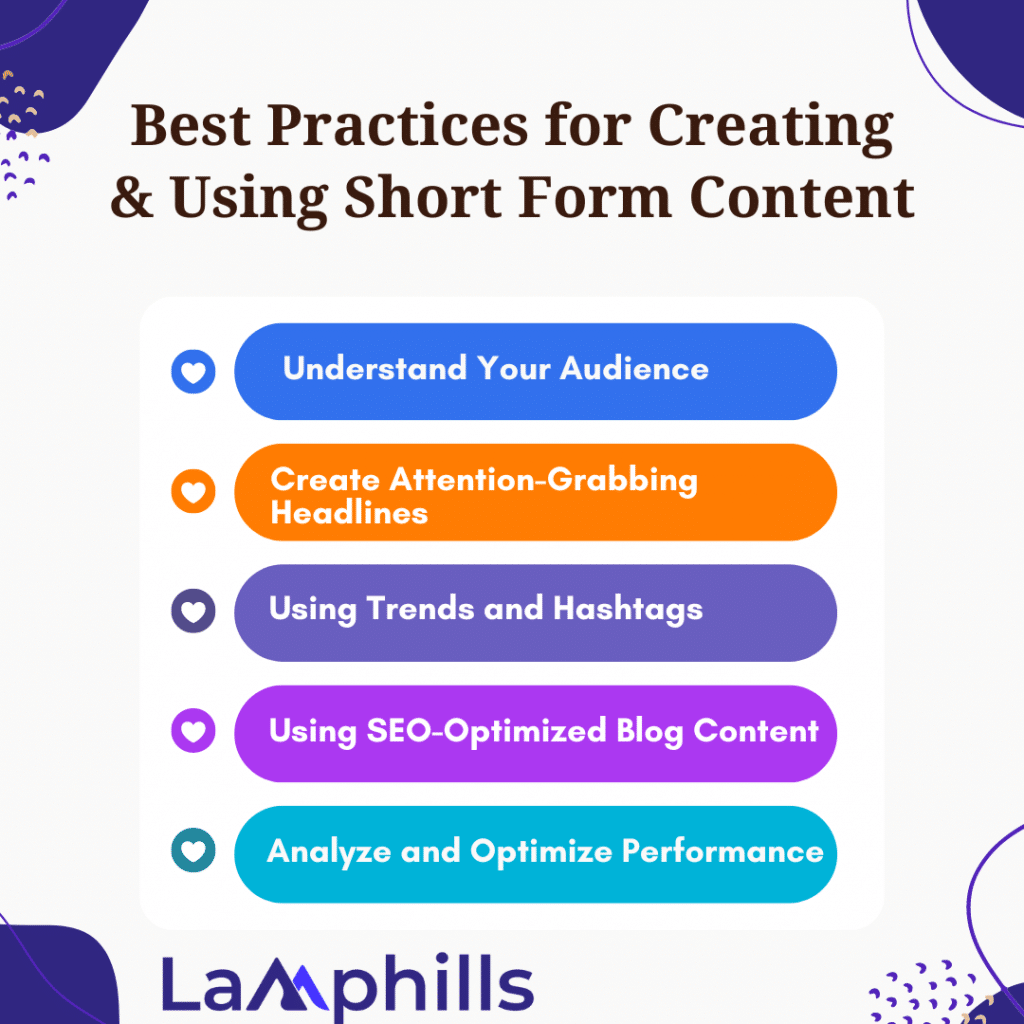Have you observed an increase in short-form content on social media?
Nowadays, it is increasingly common to find everything you want, such as where to eat in your city, the latest sporting trends, or forthcoming cultural events near you, with the click of a mouse. Creating short-form content may benefit business owners, marketers, and influencers by reaching their target audience, increasing brand visibility, and driving conversions. In this article, I’ll reveal insider insights that will help you transform your content strategy.
What is Short-form Content?
Short-form content is any type of content that your audience can easily and rapidly consume, whether through reading, watching, or listening.
When written, short-form content is often less than 1,000 words long.
Examples include short blog postings, social media posts, and emails.
When it comes to visual content, such as short videos, it usually lasts less than three minutes.
Examples include TikToks, YouTube Shorts, Instagram Reels, and Facebook Reels.
What are the Benefits of Short-form Content?
When I first started, I believed that longer content meant higher engagement. Nonetheless, the digital world has altered. Attention spans are short, and viewers prefer rapid, digestible content. Microsoft’s study found that the average human attention span is currently only eight seconds. This trend makes short-form content critical for grabbing and maintaining viewer attention.
As you can undoubtedly see, we love short-form content. Here’s why.
- Improved audience engagement: Short-form content attracts readers’ attention quickly, resulting in increased engagement rates and simple information to digest while on the go.
- Readers can easily comprehend and remember: Short-form content provides short-form pleasure while conveying concentrated messages that are easier for the audience to grasp and retain.
- More accessible: Short-form content is easy to consume on a range of devices, including smartphones and tablets.
- Quick production turnaround: Short-form content can be created more quickly and with fewer resources than long-form content. As any copywriter will tell you, it’s often more difficult to condense a message into a concise update than an 800-word blog!
- Easily optimized for social media: Social media sites frequently prefer short-form content due to its shareability and ability to retain user engagement. Short-form videos are 2.5 times more interesting than long-form videos, according to social media content consumers.
- Cost-effectiveness: Short-form content is frequently less expensive to create, making it an appealing alternative for firms with limited resources.
- Higher Click-Through Rates (CTR): Short, appealing messages entice users to click on links, increasing website traffic and potential conversions.
Short-form content is easily adaptable across platforms, including social media and email marketing.
What are the Best Types of Short-form Content?
Now, let’s look at some of the most effective short-form content.
#1. Short-form video
According to HubSpot’s 2023 Social Media Marketing Report, 33% of over 1000 social media marketers questioned want to prioritize investment in this content format. Short-form video content is extremely popular, providing a dynamic, highly shareable format for engaging audiences across a range of devices. Whether it’s a 15-second clip to increase brand awareness or a five-minute instructional video, TikTok and other short-form video platforms are an effective and entertaining addition to your marketing arsenal.
Top Tips:
- To maximize impact, keep videos under 60 seconds long.
- Pay close attention to lighting, audio quality, and compelling storytelling.
#2. Short-form podcasts
Short-form podcasts are an easy way to give valuable content to your audience, allowing users to ingest information while multitasking. Mini-podcasts, as they are commonly referred to, are an excellent format for co-hosting with industry influencers and thought leaders, as well as for developing long-term consumer relationships. Long-form podcasts can be time-consuming to produce; therefore, mini-podcasts could be an excellent answer for firms that are unable to commit to a long-term strategy.
Top Tips:
- Keep episodes focused and informative, and tailor them to your target audience’s interests.
- Make a theme and run with it. A list of advice or a weekly/daily diary about your team or business could work.
#3. Short-form blog postings
Blog entries that take more than seven minutes to read have a lower engagement rate, but we hope you’ll keep reading until the end!
Guides like these necessitate a long-form approach, although short-form essays are as effective. A 200-word blog could be ideal for covering a topic that only requires a summary or for serving as a teaser for a larger content item, such as an e-book or whitepaper.
Top tip:
- If short-form blogs are useful, consider repurposing them into a longer guide or video tutorial.
- Include multimedia components such as photographs and movies to help communicate the bigger story and bring your written content to life.
#4. Infographics
Infographics use text and images to condense complex information into understandable visualizations. They are one of the most impactful short-form content types, and they are also quite successful for sharing.
Top Tips:
Concentrate on a single story or statistic for maximum impact.
Ensure that the design makes the data or point of the infographic clear from the start.
Some of the Top Short-form Content Platforms
Short-form content thrives on a variety of channels, each tailored to a unique niche.
#1. TikTok
TikTok specializes in creating ultra-short content. Its user-friendly design and innovative features have altered communication for both brands and individuals. The app’s small video style promotes innovation, leading to viral trends and challenges.
TikTok’s technology ensures that targeted content reaches the intended audience. Brands leverage their enormous global user base to create visually appealing, succinct content spanning training, humor, and storytelling, assisting marketers in establishing genuine audience relationships with their audience.
TikTok users prefer authentic, relatable, and organic content. Engage with popular challenges creatively, adding your brand personality throughout each video.
#2. LinkedIn
LinkedIn is a fantastic medium for providing industry insights, corporate updates, and thought leadership content. When sharing content, make sure it is truly valuable and professional. There are many prominent people on LinkedIn, so you’ll want to convey your brand as effectively as possible. So, no clickbait or provocative content!
Tip: Use LinkedIn Stories and native video tools for short-form content delivery.
#3. YouTube
With 2.7 million active users, YouTube is a formidable long- and short-form video medium with a large audience and reach. According to Think With Google, 80% of consumers use both online search and video to study products, and 50% believe online video has helped them make a final purchase decision.
YouTube is ideal for assisting clients with difficulties, showing products or services, and sharing the story of your company and its people. For example, you might use your own branded YouTube channel to serialize how-to videos, events or behind-the-scenes content, or introduce staff members. Consider what your audience will respond to regularly and test out some ideas.
Tip: Optimize video names, descriptions, and tags for search engine visibility.
Need inspiration or assistance in creating videos? Check out the YouTube Creators Hub.
#4. Instagram
Instagram remains popular, with 1.21 million monthly active users. Particularly Instagram Stories and Reels, is designed for short-form visual content, making it an excellent platform for visually attractive brands. As with the platforms listed above, it’s about identifying an enduring theme or captivating one-off postings and experimenting to see what resonates with your audience, so remember to check your engagement metrics frequently and adjust your strategy accordingly.
Tip: Use Instagram’s interactive features like polls, questionnaires, and countdowns to increase engagement.
#5. Facebook
Facebook provides a variety of content types, such as short-form films, carousel posts, and photo albums, to meet the needs of its broad audience.
Tip: Use Facebook Live for real-time conversations and Q&A with your audience.
Best Practices for Creating and Using Short Form Content

Step #1. Understand Your Audience
A thorough understanding of your target audience is essential for any effective content strategy. I discovered this the hard way when my initial pieces, intended at a broad audience, failed to garner traction.
How to Implement It: 1. Conduct audience research using Google Analytics, social media insights, and surveys to understand their demographics, preferences, and behavior.
- Buying Personas: Develop detailed buyer personas to drive your content creation. Understanding your audience’s pain spots, hobbies, and desires allows you to personalize your content to their needs.
Step #2. Create Attention-Grabbing Headlines
The title is the first thing your audience sees and decides whether or not they engage with your content. I’ve discovered that a fascinating headline can dramatically improve the success of your posts.
How To Implement It:
- Use Numbers and Lists. Headlines using numbers or lists tend to fare better. For example, “5 Secrets to Creating Viral Content” is more appealing than a generic title.
- Invoke Curiosity: Pique your audience’s interest with headlines that promise value or provide insider information. Phrases such as “You Won’t Believe” or “The Secret to” can generate clicks.
Step #3. Create Engaging Content
The key to short-form content is to provide value immediately. This entails making every word count and ensuring that your message is concise and appealing.
How To Implement It:
- Brevity: Keep your posts concise. Aim for 50–100 words for social media postings and less than 500 words for blog pieces.
- Visuals: Use eye-catching visuals. ones featuring photos or videos receive 94% more views than text-only ones (source: HubSpot).
- Calls to action (CTAs): Finish with a powerful CTA. A clear CTA, whether it prompts your audience to remark, share, or click a link, can increase engagement and conversions.
Step #4. Using Trends and Hashtags
Staying current with trends and adopting appropriate hashtags can dramatically enhance your reach. I recall a post I made during a viral trend that generated three times the engagement of my typical content.
How To Implement It:
- Trend Monitoring: Use Google Trends, BuzzSumo, and social media sites to uncover popular themes in your business.
- Research using hashtags: Use popular and relevant hashtags to boost your post’s discoverability. Hashtagify and other tools can help you identify trending hashtags.
Step #5. Analyze and Optimize Performance
Content creation does not end with publishing. Continuous analysis and optimization are essential for AI success.
How To Implement It:
- Metrics: Monitor critical metrics, including engagement, shares, click-through rates, and conversions. Platforms such as Facebook Insights and Twitter Analytics provide useful data.
- A/B testing: Experiment with different headlines, images, and CTAs to see what works best for your audience. Use the information to improve your strategy.
I recall posting a short, hilarious video on Instagram. It was a spur-of-the-moment notion, and I didn’t have high expectations. To my amazement, the video went viral, racking up thousands of views and dramatically increasing my follower count. This experience taught me the value of spontaneity and sincerity in short-form content.
Analyzing and Monitoring Outcomes of Short-form Content
Analyzing the performance of your short-form content is critical for refining your approach and increasing its effect.
Metrics to track includes;
- Engagement metrics: Track likes, shares, comments, and click-through rates to assess audience engagement.
- Conversion rates: Determine the percentage of viewers that took a desired action after engaging with your content.
- Reach and Impressions: Monitor the number of unique viewers and total impressions to determine the visibility of your content.
Read Also: Monitoring Online Content: How To Do This In 5 Steps
Tools for Analyzing Performance of Short Form Content
- Google analytics: Use Google Analytics to monitor website traffic, user behavior, and conversion rates.
- Social media insights: Platforms such as Facebook Insights and Twitter Analytics provide detailed information about your content’s performance.
- SEO tools: SEMrush and Moz can help you track keyword rankings and organic search traffic.
Social Media Post Templates
Templates can help you create content that is consistent and efficient. A short-form content template can help you arrange your pieces, making the process faster and more efficient.
Example: A social media post template may feature sections for the headline, main message, visual content, hashtags, and call-to-action. This guarantees that all essential aspects are present and makes it simple to routinely produce high-quality postings.
Streamline your social media strategy with our comprehensive Social Media Post Template. Download it now and start creating engaging, effective posts today!
Conclusion
In today’s fast-paced digital environment, mastering short-form content is critical for engaging audiences and capturing their attention. You can produce viral, money-making posts by researching your audience, writing great headlines, providing interesting content, capitalizing on trends, and constantly tweaking your strategy. Don’t forget to use templates to streamline your workflow and maintain consistency.
Are you prepared to revolutionize your content strategy and master short-form content? What is your experience with making viral posts? Share your insights and let’s learn from one another!





